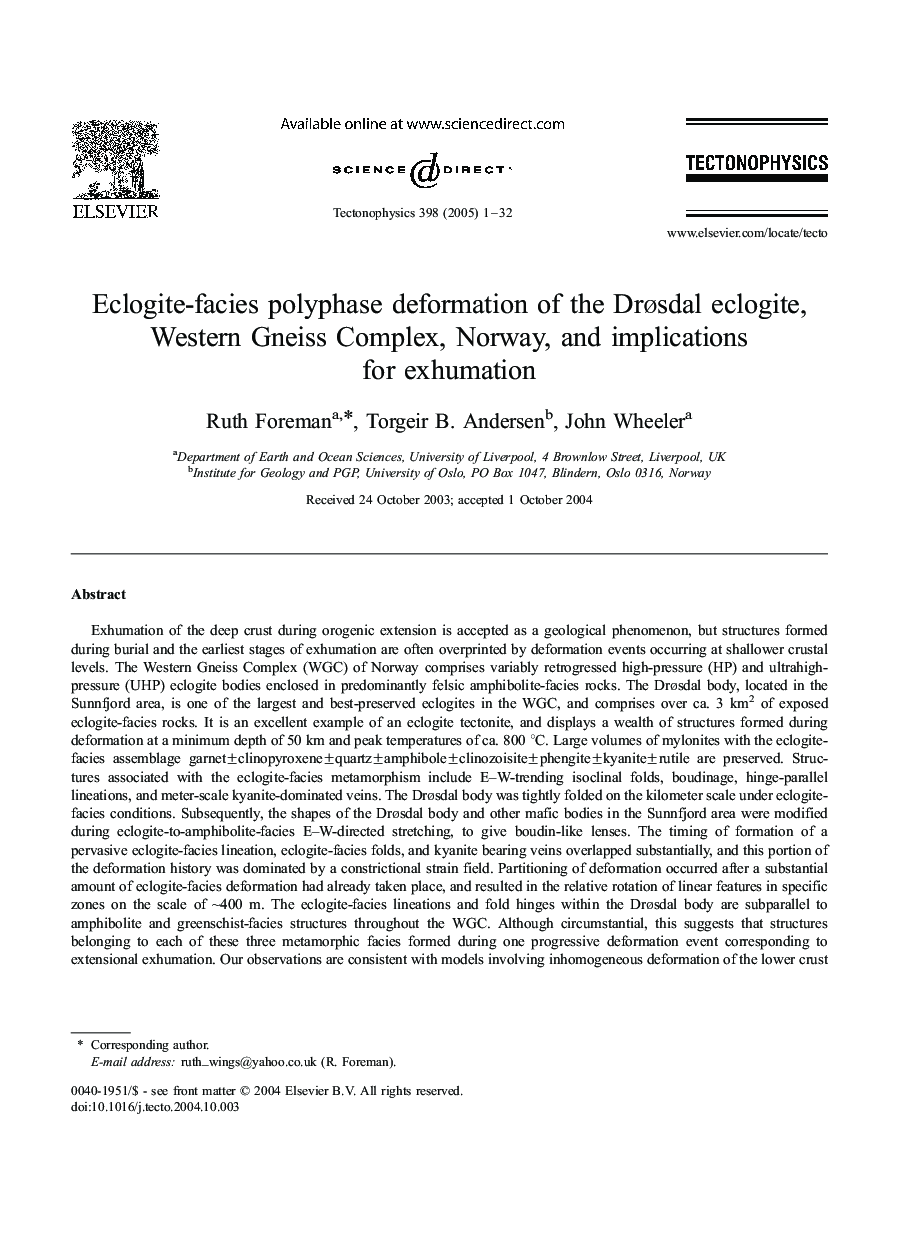| کد مقاله | کد نشریه | سال انتشار | مقاله انگلیسی | نسخه تمام متن |
|---|---|---|---|---|
| 9527297 | 1636985 | 2005 | 32 صفحه PDF | دانلود رایگان |
عنوان انگلیسی مقاله ISI
Eclogite-facies polyphase deformation of the Drøsdal eclogite, Western Gneiss Complex, Norway, and implications for exhumation
دانلود مقاله + سفارش ترجمه
دانلود مقاله ISI انگلیسی
رایگان برای ایرانیان
کلمات کلیدی
موضوعات مرتبط
مهندسی و علوم پایه
علوم زمین و سیارات
فرآیندهای سطح زمین
پیش نمایش صفحه اول مقاله

چکیده انگلیسی
Exhumation of the deep crust during orogenic extension is accepted as a geological phenomenon, but structures formed during burial and the earliest stages of exhumation are often overprinted by deformation events occurring at shallower crustal levels. The Western Gneiss Complex (WGC) of Norway comprises variably retrogressed high-pressure (HP) and ultrahigh-pressure (UHP) eclogite bodies enclosed in predominantly felsic amphibolite-facies rocks. The Drøsdal body, located in the Sunnfjord area, is one of the largest and best-preserved eclogites in the WGC, and comprises over ca. 3 km2 of exposed eclogite-facies rocks. It is an excellent example of an eclogite tectonite, and displays a wealth of structures formed during deformation at a minimum depth of 50 km and peak temperatures of ca. 800 °C. Large volumes of mylonites with the eclogite-facies assemblage garnet±clinopyroxene±quartz±amphibole±clinozoisite±phengite±kyanite±rutile are preserved. Structures associated with the eclogite-facies metamorphism include E-W-trending isoclinal folds, boudinage, hinge-parallel lineations, and meter-scale kyanite-dominated veins. The Drøsdal body was tightly folded on the kilometer scale under eclogite-facies conditions. Subsequently, the shapes of the Drøsdal body and other mafic bodies in the Sunnfjord area were modified during eclogite-to-amphibolite-facies E-W-directed stretching, to give boudin-like lenses. The timing of formation of a pervasive eclogite-facies lineation, eclogite-facies folds, and kyanite bearing veins overlapped substantially, and this portion of the deformation history was dominated by a constrictional strain field. Partitioning of deformation occurred after a substantial amount of eclogite-facies deformation had already taken place, and resulted in the relative rotation of linear features in specific zones on the scale of â¼400 m. The eclogite-facies lineations and fold hinges within the Drøsdal body are subparallel to amphibolite and greenschist-facies structures throughout the WGC. Although circumstantial, this suggests that structures belonging to each of these three metamorphic facies formed during one progressive deformation event corresponding to extensional exhumation. Our observations are consistent with models involving inhomogeneous deformation of the lower crust during early orogenic extension. We envisage that transtensional (noncoaxial) deformation dominated the extensional deformation of the WGC, but that coaxial deformation must have occurred locally.
ناشر
Database: Elsevier - ScienceDirect (ساینس دایرکت)
Journal: Tectonophysics - Volume 398, Issues 1â2, 30 March 2005, Pages 1-32
Journal: Tectonophysics - Volume 398, Issues 1â2, 30 March 2005, Pages 1-32
نویسندگان
Ruth Foreman, Torgeir B. Andersen, John Wheeler,